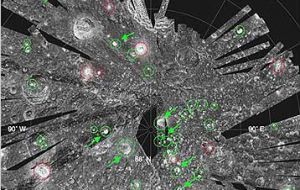MercoPress. South Atlantic News Agency
Moon’s North Pole packed with ice revives hopes of human colonization
 The Indian Chandrayaan-1 spacecraft which made the discovery with NASA instruments
The Indian Chandrayaan-1 spacecraft which made the discovery with NASA instruments New analysis of scientific data from a NASA instrument aboard the 2008 Indian moon mission Chandrayaan-1 has detected more than 40 ice-filled craters in the lunar North Pole, reviving hopes for colonization of the moon by humans in future.
The new data, published in the Geophysical Research Letters by US and Indian scientists, suggests that there could be at least 600 million metric tons of water ice in the craters.
“Using data from a NASA radar that flew aboard India’s Chandrayaan-1 spacecraft, scientists have detected ice deposits near the moon’s north pole. It’s estimated there could be at least 600 million metric tons of water ice,” NASA reported on Tuesday.
“The new discoveries by Chandrayaan-1 and other lunar missions show that the moon is an even more interesting and attractive scientific, exploration and operational destination than people had previously thought,” Prof Paul Spudis, Principal Investigator of the Mini-SAR, was quoted as saying in an ISRO statement.
Though Chandrayaan-1 and NASA missions like the Lunar Crater Observation and Sensing Satellite (LCROSS) have reported the presence of water on the moon, this is the first time that evidence has emerged of the presence of large quantities of lunar water.
“Once you have such large quantities of water it will help in setting up colonies,” said ISRO spokesperson S Satish on the publication of the Mini-SAR finding.




Top Comments
Disclaimer & comment rulesCommenting for this story is now closed.
If you have a Facebook account, become a fan and comment on our Facebook Page!